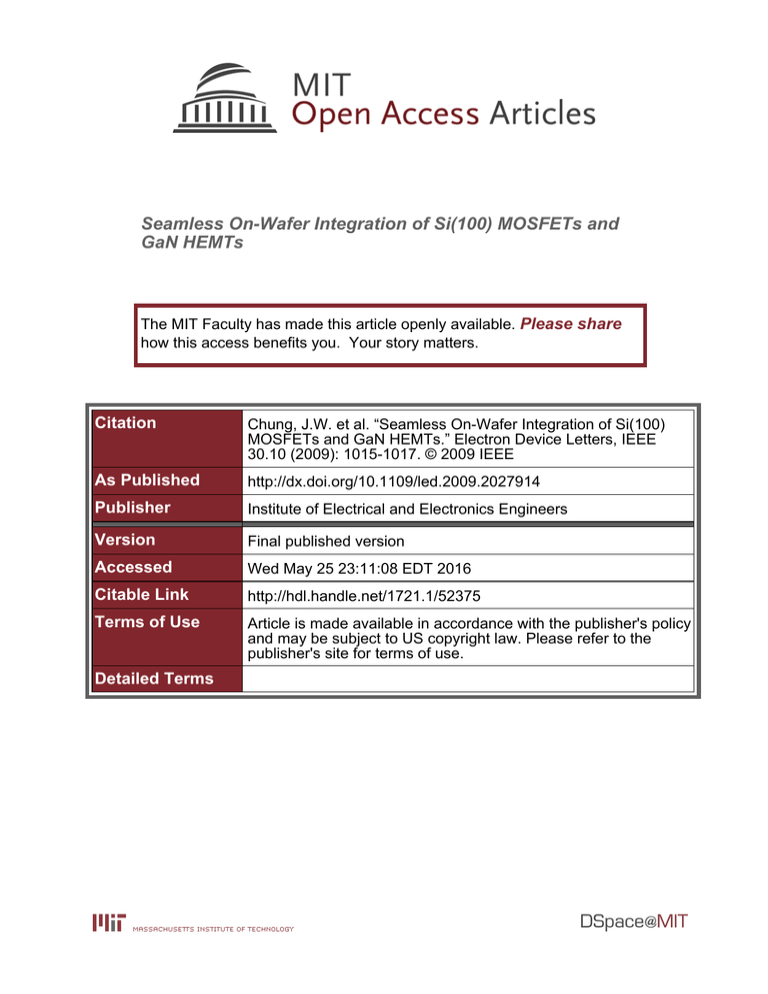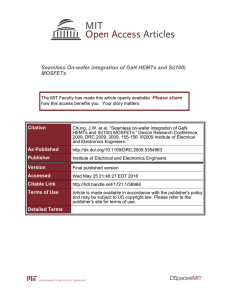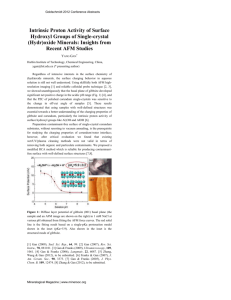Seamless On-Wafer Integration of Si(100) MOSFETs and GaN HEMTs Please share
advertisement

Seamless On-Wafer Integration of Si(100) MOSFETs and GaN HEMTs The MIT Faculty has made this article openly available. Please share how this access benefits you. Your story matters. Citation Chung, J.W. et al. “Seamless On-Wafer Integration of Si(100) MOSFETs and GaN HEMTs.” Electron Device Letters, IEEE 30.10 (2009): 1015-1017. © 2009 IEEE As Published http://dx.doi.org/10.1109/led.2009.2027914 Publisher Institute of Electrical and Electronics Engineers Version Final published version Accessed Wed May 25 23:11:08 EDT 2016 Citable Link http://hdl.handle.net/1721.1/52375 Terms of Use Article is made available in accordance with the publisher's policy and may be subject to US copyright law. Please refer to the publisher's site for terms of use. Detailed Terms IEEE ELECTRON DEVICE LETTERS, VOL. 30, NO. 10, OCTOBER 2009 1015 Seamless On-Wafer Integration of Si(100) MOSFETs and GaN HEMTs Jinwook W. Chung, Jae-kyu Lee, Edwin L. Piner, Member, IEEE, and Tomás Palacios, Member, IEEE Abstract—The first on-wafer integration of Si(100) MOSFETs and AlGaN/GaN high electron mobility transistors (HEMTs) is demonstrated. To enable a fully Si-compatible process, we fabricated a novel Si(100)–GaN–Si(100) virtual substrate through a wafer bonding and etch-back technique. The high thermal stability of nitride semiconductors allowed the fabrication of Si MOSFETs on this substrate without degrading the performance of the GaN epilayers. After the Si devices were fabricated, the nitride epilayer is exposed, and the nitride transistors are processed. By using this technology, GaN and Si devices separated by less than 5 µm from each other have been fabricated, which is suitable for building future heterogeneous integrated circuits. Index Terms—GaN, heterogeneous integration, high electron mobility transistor (HEMT), metal–oxide–semiconductor fieldeffect transistor (MOSFET), Si(100), virtual substrate. I. I NTRODUCTION T HE integration of III–V compound semiconductors and silicon (100) CMOS technologies has been a long pursued goal. A robust heterogeneous integration technology would make the outstanding analog and mixed-signal performance of compound semiconductor electronics available to design these key functions on VLSI chips that are difficult to implement in Si technology. GaN-based devices are one of the best candidates for integration with Si. While Si electronics has shown unsurpassed levels of scaling and circuit complexity, GaN devices offer excellent high-frequency/power performance as well as outstanding optoelectronic properties [1], [2]. The ability to combine these two material systems in the same chip and in very close proximity would allow unprecedented flexibility for advanced applications. Previously, several authors have reported heterogeneous integration of Si and GaAs devices (i.e., field-effect transistors and light-emitting diodes) by the low-temperature selective epitaxial growth of GaAs on a miscut Si(100) substrate [3]–[5]. With similar technology, several groups have reported the growth Manuscript received June 16, 2009. First published August 28, 2009; current version published September 29, 2009. This work was supported in part by a DARPA Young Faculty Award, monitored by Dr. M. Rosker, and in part by the Interconnect Focus Center. The work of J. W. Chung was supported by the Korea Foundation for Advanced Studies. The review of this letter was arranged by Editor G. Meneghesso. J. W. Chung, J. Lee, and T. Palacios are with the Microsystems Technology Laboratories, Massachusetts Institute of Technology, Cambridge, MA 02139 USA (e-mail: wilchung@mit.edu; jkleesec@mit.edu; tpalacios@mit.edu). E. L. Piner is with Nitronex Corporation, Durham, NC 27703 USA (e-mail: epiner@nitronex.com). Color versions of one or more of the figures in this letter are available online at http://ieeexplore.ieee.org. Digital Object Identifier 10.1109/LED.2009.2027914 of GaN structures on miscut Si(100) or Si(110) substrates by molecular beam epitaxy [6], [7] and metalorganic vapor phase epitaxy [8], [9]. However, this approach is challenging because of the difficulty of growing high-quality Wurtzite GaN on these substrates [9]. Moreover, the use of miscut substrates increases the density of surface states in the Si material, degrading the performance of Si electronics designed therein. A different approach to achieve the heterogeneous integration of GaN and Si involves transferring an already grown GaN epilayer onto a Si(100) substrate through the removal of the original substrate and subsequent bonding to the Si(100) wafer. Laser lift-off and Au/In/Au bonding layer were used in [10]. Wafer bonding of GaN with Si substrates using PdIn3 and AuGe as an interlayer has also been reported in [11] and [12]; however, none of these hybrid wafers satisfies the thermal budget of Si processing (∼1000 ◦ C) since the melting points of PdIn3 and AuGe are ∼660 ◦ C and ∼360 ◦ C, respectively. Recently, our group demonstrated the robust wafer bonding of GaN and Si(100) wafers through the use of a SiO2 interlayer [13]. The thermal stability of this bonding was successfully tested up to 1000 ◦ C, a sufficient thermal budget for Si and GaN processing. In this letter, we demonstrate the first integration of Si(100) MOSFETs and GaN high electron mobility transistors (HEMTs) on the same wafer in very close proximity. The key enabling technology is the fabrication of a Si(100)–GaN– Si(100) virtual substrate through a wafer bonding and etch-back process. On this substrate, standard Si MOSFETs were first fabricated. Then, the top Si layer was locally removed, exposing the AlGaN surface, and GaN HEMT devices were processed in those regions. It should be highlighted that in our technology, the Si devices are fabricated on Si(100) wafers without any miscut and following a conventional Si process flow. Due to the very high thermal stability of GaN [14], this process did not adversely affect the electrical properties of the embedded GaN layer. II. D EVICE FABRICATION Fig. 1 summarizes the main steps of the fabrication of Si(100)–GaN–Si(100) virtual substrates. The Si(100)–GaN– Si(100) virtual substrate fabrication begins with the epitaxial growth of an AlGaN/GaN transistor structure on a Si(111) substrate by metal–organic chemical vapor deposition at Nitronex Corporation. In these samples, the AlGaN barrier had a total thickness of 175 Å and an Al composition of 26%. Our technology then removes the original Si(111) substrate and applies wafer bonding twice to have Si(100) substrates on both the 0741-3106/$26.00 © 2009 IEEE Authorized licensed use limited to: MIT Libraries. Downloaded on November 23, 2009 at 17:07 from IEEE Xplore. Restrictions apply. 1016 IEEE ELECTRON DEVICE LETTERS, VOL. 30, NO. 10, OCTOBER 2009 Fig. 1. Schematic illustration of the main processing steps in the fabrication of Si(100)–GaN–Si(100) virtual substrates through the layer transfer technology described in [13]. The thin top Si(100) layer is obtained from the active Si layer of a silicon-on-insulator wafer. The doping of this layer sets the nMOS or pMOS character of the fabricated devices. The Si(111) substrate removal in step 3 is performed in a deep reactive ion etch system using an SF6 -based plasma. The fabrication process of the Si–GaN–Si virtual substrates can be simplified by leaving the Si(111) substrate and skipping steps 3 and 4. Fig. 2. Cross-sectional SEM image of the Si–GaN–Si virtual substrate. top and bottom sides of the AlGaN/GaN layer. The top Si(100) layer has a thickness of 200 nm and a donor doping concentration of 1015 cm−3 . Our wafer bonding technology has been described in [13], and it is based on spin-coating the GaN wafer with hydrogen silsesquioxane (HSQ), followed by thermal compression with the Si wafer at 400 ◦ C for 1 h. HSQ is a flowable oxide with excellent thermal stability, which withstands the high thermal budget required during the processing of both Si and GaN devices (i.e., > 1000 ◦ C). Following this technology, hybrid wafers with 1-in diameter have been obtained. Once the virtual substrate has been fabricated (Fig. 2), device processing starts with the fabrication of Si p-MOSFETs. Device isolation was achieved by a field oxide, and a 10-nm gate oxide was formed by plasma-enhanced chemical vapor deposition (PECVD). Undoped polycrystalline Si was subsequently deposited and anisotropically etched in a Cl2 plasma to form the gate contact. The source, drain, and gate implantation was achieved at the same time with a species of BF2 , a dose of 4 × 1015 cm−2 , and an implantation energy of 10 keV. To fabricate GaN HEMTs, the AlGaN/GaN layer embedded in the virtual substrate was exposed by etching the top Si(100) and HSQ layers using SF6 plasma followed by buffered oxide etchant in those regions where GaN devices are to be located. The etch selectivity between Si/SiO2 and AlGaN is excellent, and a smooth AlGaN surface was obtained after the etch. Once the AlGaN/GaN layer is exposed, the fabrication of GaN HEMTs is identical to a standard GaN HEMT process. A Ti/Al/Ni/Au multilayer was first deposited for the ohmic contacts. Ohmic metal alloying in the GaN HEMTs and Fig. 3. (a) Cross-sectional schematic of fabricated Si p-MOSFETs and GaN HEMTs. (b) Plan-view SEM image of the fabricated transistors. dopant activation in the Si p-MOSFETs were simultaneously accomplished by rapid thermal annealing at 870 ◦ C for 30 s in N2 atmosphere. A Cl2 /BCl3 plasma was used for the mesa isolation of the HEMT devices, and then, a 2–3-µm-long gate was formed by photolithography and Ni/Au/Ni metallization. Fig. 3 shows a scanning electron micrograph (SEM) image of the integrated Si p-MOSFETs and GaN HEMT devices after this step. The separation between these two devices is just 4 µm. Finally, 500 nm of SiO2 passivation layer was deposited by PECVD, contact vias were opened in the dielectric, and the contact pads and interconnections were metalized with Ti/Al. III. R ESULTS AND D ISCUSSION The drain current versus drain voltage characteristics, as well as the transfer characteristics, of a typical Si p-MOSFET and GaN HEMT fabricated using the technology described earlier are shown in Fig. 4. Both devices have good modulation of the drain current by the gate contact as well as low off-currents. However, the long gate lengths of these devices limited their maximum output current. The use of a shorter gate length and higher doping levels in the Si active layer is expected to improve the performance of the MOSFETs, and it is part of our on-going work. The effect of the entire fabrication process to the transport properties of the AlGaN/GaN epilayer was evaluated by Authorized licensed use limited to: MIT Libraries. Downloaded on November 23, 2009 at 17:07 from IEEE Xplore. Restrictions apply. CHUNG et al.: SEAMLESS ON-WAFER INTEGRATION OF Si(100) MOSFETs AND GaN HEMTs 1017 Fig. 4. (a) DC current–voltage characteristics (left) and transfer curve (right) of a long-channel Si p-MOSFET (LG = 8 µm). (b) DC current–voltage characteristics (left) and transfer curve (right) of a GaN HEMT (LG = 2 µm). transfer length measurements and compared to conventional devices. The contact resistance (Rc ) did not change (0.3 − 0.4 Ω · mm); however, the sheet resistance (Rsh ) was reduced by 24%, from 476 to 364 Ω/sq. This improvement in Rsh is due to the layer transfer process, and it was also reported in [13]. IV. C ONCLUSION We have demonstrated the first on-wafer integration of GaN-based devices and Si(100) electronics through a fully Si-compatible process. This integration allows device-level integration of compound semiconductors (transistors, LEDs, lasers, etc.) and Si-based transistors on the same wafer to enable revolutionary advances in circuits and systems. Some of the applications envisioned for this integration include highpower integrated wireless transmitters, power gating and power conversion circuits, and in-chip optical interconnections where the optoelectronic devices are made of nitride semiconductors and the digital circuit is based on Si devices. [5] [6] [7] [8] [9] [10] [11] R EFERENCES [1] U. K. Mishra, L. Shen, T. E. Kazior, and Y.-F. Wu, “GaN-based RF power devices and amplifiers,” Proc. IEEE, vol. 96, no. 2, pp. 287–305, Feb. 2008. [2] S. Nakamura, G. Fasol, and S. J. Pearton, The Blue Laser Diode: The Complete Story. Berlin, Germany: Springer-Verlag, 2000. [3] R. Fischer, T. Henderson, J. Klem, W. Kopp, C. K. Peng, and H. Morkoc, “Monolithic integration of GaAs/AlGaAs modulation-doped field-effect transistors and N-metal-oxide-semiconductor silicon circuits,” Appl. Phys. Lett., vol. 47, no. 9, pp. 983–985, Nov. 1985. [4] R. N. Ghosh, B. Griffing, and J. M. Ballantyne, “Monolithic integration of GaAs light-emitting diodes and Si metal-oxide-semiconductor [12] [13] [14] field-effect transistors,” Appl. Phys. Lett., vol. 48, no. 5, pp. 370–371, Feb. 1986. H. K. Choi, G. W. Turner, and B.-Y. Tsaur, “Monolithic integration of Si MOSFETs and GaAs MESFETs,” IEEE Electron Device Lett., vol. EDL7, no. 4, pp. 241–243, Apr. 1986. S. Joblot, F. Semond, Y. Cordier, P. Lorenzini, and J. Massies, “Highelectron-mobility AlGaN/GaN heterostructures grown on Si(001) by molecular-beam epitaxy,” Appl. Phys. Lett., vol. 87, no. 13, p. 133 505, Sep. 2005. Y. Cordier, J.-C. Moreno, N. Baron, E. Frayssinet, S. Chenot, B. Damilano, and F. Semond, “Demonstration of AlGaN/GaN highelectron-mobility transistors grown by molecular beam epitaxy on Si(110),” IEEE Electron Device Lett., vol. 29, no. 11, pp. 1187–1189, Nov. 2008. F. Schulze, O. Kisel, A. Dadgar, A. Krtschil, J. Blasing, M. Kunze, I. Daumiller, T. Hempel, A. Diez, R. Clos, J. Christen, and A. Krost, “Crystallographic and electric properties of MOVPE-grown AlGaN/GaNbased FETs on Si(001) substrates,” J. Cryst. Growth, vol. 299, no. 2, pp. 399–403, Feb. 2007. A. Dadgar, F. Schulze, M. Wienecke, A. Gadanecz, J. Blasing, P. Veit, T. Hempel, A. Diez, J. Christen, and A. Krost, “Epitaxy of GaN on silicon—Impact of symmetry and surface reconstruction,” New J. Phys., vol. 9, no. 10, p. 389, Oct. 2007. H. Ji, J. Das, M. Germain, and M. Kuball, “Laser lift-off transfer of AlGaN/GaN HEMTs from sapphire onto Si: A thermal perspective,” Solid State Electron., vol. 53, no. 5, pp. 526–529, Apr. 2009. W. S. Wong, Y. Cho, E. R. Weber, T. Sands, K. M. Yu, J. Kruger, A. B. Wengrow, and N. W. Cheung, “Structural and optical quality of GaN/metal/Si heterostructures fabricated by excimer laser lift-off,” Appl. Phys. Lett., vol. 75, no. 13, pp. 1887–1889, Sep. 1999. M. Funato, S. Fujita, and S. Fujita, “Integration of GaN with Si using a AuGe-mediated wafer bonding technique,” Appl. Phys. Lett., vol. 77, no. 24, pp. 3959–3961, Dec. 2000. J. W. Chung, E. L. Piner, and T. Palacios, “N-face GaN/AlGaN HEMTs fabricated through layer transfer technology,” IEEE Electron Device Lett., vol. 30, no. 2, pp. 113–116, Feb. 2009. M. Kuball, F. Demangeot, J. Frandon, M. A. Renucci, J. Massies, N. Grandjean, R. L. Aulombard, and O. Briot, “Thermal stability of GaN investigated by Raman scattering,” Appl. Phys. Lett., vol. 73, no. 7, pp. 960–962, Aug. 1998. Authorized licensed use limited to: MIT Libraries. Downloaded on November 23, 2009 at 17:07 from IEEE Xplore. Restrictions apply.

![Structural and electronic properties of GaN [001] nanowires by using](http://s3.studylib.net/store/data/007592263_2-097e6f635887ae5b303613d8f900ab21-300x300.png)





